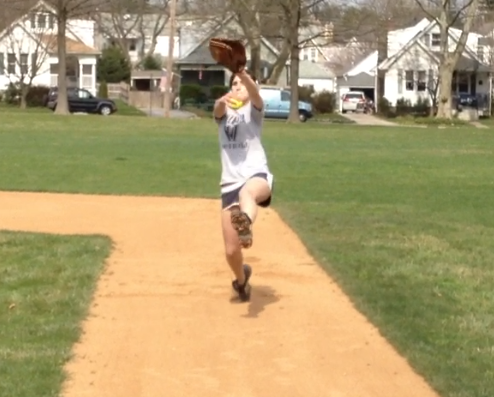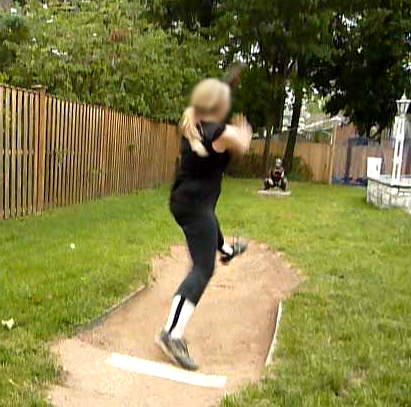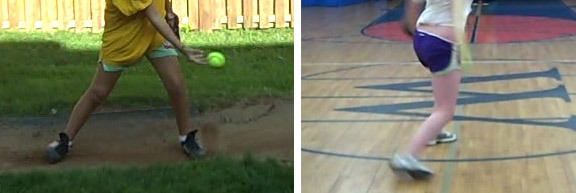Is Your Pre-motion Hurting Your Pitch? Part 2
Welcome back to my series on the pre-motion part of the windmill pitch! I’m explaining the most common problematic pre-motion issues I’ve seen among windmill pitchers, and how those issues can set the stage for a sub-optimal pitch before the bulk of the pitching motion has even begun. In my last post, I discussed the load and the problems that can arise if you’re doing a reverse load. In this post, we’ll be talking in depth about a tiny little 3-6 inch movement in your load foot that has the power to destroy one of the most important aspects of the pitch: the drive through. Unfortunately, this is an extremely common problem. Does it affect you?
Are You Turning Your Drive Foot During Your Pre-motion?
Over many years of working with my own students and also watching other pitchers in tournaments or on TV, I’ve seen a lot of pitchers load like this:

Notice how the toes of the load foot are not pointing in the same direction as the power line. If you haven’t read our intro to pitching terms, the power line is the straight line that connects your drive foot to your target. To achieve maximum pitch speed, ALL of your energy should move down the power line. If your toes aren’t pointing at your target, it’s likely your knee isn’t either, and that’s a significant amount of energy moving in another direction once you push off.
Think of it this way: you just hit a single and you’ve been given the sign to steal second. Would you run to second base with your toes pointing out? I doubt it; you’d be thrown out for sure! Even though we’re only talking about one push with windmill pitching, you’re getting the same loss of power as you would if you tried to steal second with your feet turned sideways.
Take a look at this slow-motion video. Watch the drive foot carefully and notice when it turns:
The drive foot begins to turn right before the load, so by the time it bears weight it’s pointing away from the target. Pitchers doing a reverse load may be more likely to do this, but it affects pitchers who load forward as well.
A Weak Push-off Isn’t the Only Problem
If you’re turning your foot like this, getting a weak push off the rubber is only the BEGINNING of a chain reaction of problems you may experience in the rest of your delivery. Let’s explore them:
Your Reach may be Compromised
The reach is a very important and often overlooked part of the windmill pitching motion. At the beginning of the pitch, you must point your stride foot and both arms directly at your target with your torso facing forward before you turn into your track. A good reach looks like this:

Notice that her drive-leg knee is also pointed forward and the top of her toe is down on her drive foot.
Let’s look at a reach with a turned foot:

This is the exact same point in the pitch, and her body has already begun to track. Why? Stand up with your feet about hip width apart. Now try to turn your hips to the side while keeping your knees facing forward. It’s impossible. You can turn your waist a little, but not your hips. Therefore, when you’re pitching, your hips will naturally drift to where your knee is pointing as you push off.
Why does this matter? Because you gain power from a fast track. The pitcher in the photo above will end up skipping the action of tracking altogether because by the time she gets to the track phase of the pitch, she will already be tracked. Her throw zone is established, so she can still throw a strike, but the pitch won’t be as fast. If you’re still facing forward at this point, as in the other picture, think about how quickly you have to track to get your throw zone established in time for the delivery. That necessity for speed puts pressure on you to move faster, thus making the pitch faster. If you’re tracked the whole time, your arm is free to move through the throw zone at a leisurely pace—not what we want in a pitch.
You Likely Won’t Be Able to Drive Through
The drive through is a TREMENDOUS source of power in a windmill pitch. A good drive through is achieved when the pitcher’s drive-leg knee powers straight down the power line, dragging the top of the toe on the ground behind it. If your knee is pointed to the side, you CANNOT drive it down the power line. In addition, since your foot is also pointed to the side, after the push off you will likely experience one of two things:
1. You will collapse onto the side of your foot. That looks like this:

Ouch. Not only is that pretty bad for your ankle, it also dramatically reduces your power. When the entire side of your foot is dragging along the ground instead of just your big toe, you’re creating A TON of extra friction that slows you down. You can see quite well in the first example that the release of the ball has taken place, and the drive through is nowhere near complete. That’s because of the friction slowing down the drive foot.
2. You will crow hop and THEN collapse onto the side of your foot. Watch that slow motion video again and notice how the foot leaves the ground and re-plants before continuing the drive through. That’s called crow hopping, and it’s also an extremely common problem (in fact, it will get its own post in the future). Crow hopping is a problem beyond how it affects your pitch because it’s illegal. If you’ve ever been called on an illegal pitch, this is very likely the culprit. There are a few reasons why a pitcher might crow hop, but one of them is her body senses that she’s about to create too much friction by dragging the whole side of her foot. In response, the reflex is to pick that foot up and put it back down closer to the end, so it doesn’t have as far to go with that intense drag.
If your knee is pointed to the side, and the whole side of your foot is dragging on the ground, you’re leg is not driving through with its own power. Instead, it’s being dragged along by the momentum of the rest of your body, like a bratty little kid being dragged from a toy store by its parent. Instead of adding to the power of your pitch, the drive leg holds you back instead. And when your lower body is holding you back, it puts too much pressure on your arm, back, and shoulders to provide all the power in the pitch, increasing your chance of injury.
How Do I Know If I’m Doing This? How Do I Fix It?
The best way to determine if you’re turning your foot is to watch yourself on video. If you’ve never seen a picture or video of yourself mid-pitch and you’re not sure, check your cleats. Are there holes or worn out spots in them? Where are they? If you’re driving through properly, you should only wear out the spot on top of or just next to your big toe on your drive through foot. If you have a toe guard, there should be no wear on a part of your shoe that isn’t protected by the toe guard.
That’s a lot of trouble caused by a tiny little move, isn’t it? Luckily, it’s one of the easiest things to fix. All you have to do is CONCENTRATE. Spend a whole practice session paying attention to your load. You can even watch your foot if you have to. Make sure your toes are pointed forward when you load, and still forward when you push off. Try to focus on driving your knee straight at the catcher during your drive through.
In part 3, I promise we’re going to move away from the feet. In the meantime, your comments are, as always, welcome!
I have a 15 year old that has the problem that you have talked about. She is dragging instead of driving!: She throws 60-62 on the radar. After about 20 pitches she has a trench dug. I have known that she would be able to throw harder if we could correct this. How can we correct this bad habbit?? If it matters she is 6’1″ and weighs about 160.
Hi Matt,
These drills (https://www.fastpitchpower.com/pitching-drills-for-smoother-drive-through/) and these exercises (https://www.fastpitchpower.com/exercises-that-correct-drive-foot-turn-out/) should help. We can also do a video analysis to determine exactly why your daughter is dragging her foot.